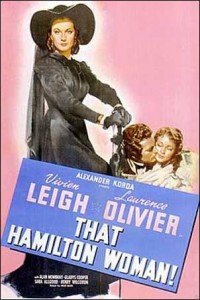 The Year’s Most Exciting Team of Screen Lovers !
The Year’s Most Exciting Team of Screen Lovers !
 The story takes place as a flashback as both the beginning and end of the film show the now destitute Lady Hamilton in what can only be described as a debtor’s prison. Her flashback – as told to another female convict – runs from her initial meeting with Lord Nelson (then just a Captain) up to his ultimate death during the battle of Trafalgar. During the tale we see their relationship grow from a clandestine affair to one of national prominence. We see Nelson torn between his country, his wife, and his mistress.
The story takes place as a flashback as both the beginning and end of the film show the now destitute Lady Hamilton in what can only be described as a debtor’s prison. Her flashback – as told to another female convict – runs from her initial meeting with Lord Nelson (then just a Captain) up to his ultimate death during the battle of Trafalgar. During the tale we see their relationship grow from a clandestine affair to one of national prominence. We see Nelson torn between his country, his wife, and his mistress.
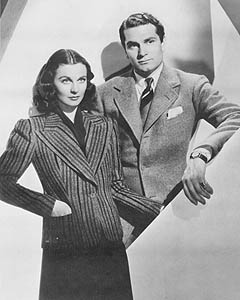 The two main protagonists are played to perfection by Vivien Leigh and Laurence Olivier, who were married at the time in addition to being professional rivals. This marks one of only three instances where the two acted together on film and That Hamilton Woman is perhaps the strongest of the three, with a close second going to Fire Over England. Here Vivien gets top billing and rightfully so- the story is truly about her and told from her viewpoint. And although Olivier gives a strong performance Leigh truly steals the show. The filming marks the only time the couple left England during the war.
The two main protagonists are played to perfection by Vivien Leigh and Laurence Olivier, who were married at the time in addition to being professional rivals. This marks one of only three instances where the two acted together on film and That Hamilton Woman is perhaps the strongest of the three, with a close second going to Fire Over England. Here Vivien gets top billing and rightfully so- the story is truly about her and told from her viewpoint. And although Olivier gives a strong performance Leigh truly steals the show. The filming marks the only time the couple left England during the war.
Filmed only a few years following her triumph in GWTW, there are a few scenes which are reminiscent of that epic: most notably Vivien sobbing to her mother and being helped to undress (although here by her mother as opposed to Mammy). Luckily these scenes all occur very early in the film and don’t detract form the story; they merely set the stage. It is especially noteworthy to note how “English” Leigh sounds here when it’s called for.
Production values here are for the most part fairly strong for the time. That Hamilton Woman was nominated for four Academy Awards, winning one (for sound recording). The other nominations were for art direction, cinematography, and special effects.
It’s pretty obvious that Olivier’s supposedly amputated arm is still securely attached although undoubtedly “squished” into oversized costumes. Fortunately he us usually shot from the other side, leaving his “armless” side either unseen or in shadow. And if anything he is NOT the lead role here anyway.
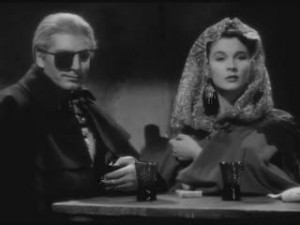 Nelson’s other key injury, the loss of his right eye, fares little better. When the injury is first introduced Olivier’s eye appears half closed, which is at least an attempt. However for most of the remainder of the film the eye appears more or less normal – at least he doesn’t wear the silly piratical black bandana eye patch save for one scene.
Nelson’s other key injury, the loss of his right eye, fares little better. When the injury is first introduced Olivier’s eye appears half closed, which is at least an attempt. However for most of the remainder of the film the eye appears more or less normal – at least he doesn’t wear the silly piratical black bandana eye patch save for one scene.
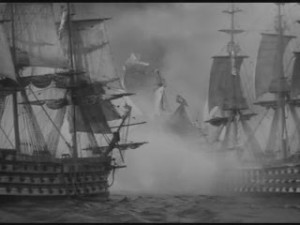 Nelson’s fleet looks quite nice however. A few shots are obviously backlit and others are quite obviously using models. Outside of a few instances the fleet looks very real and even gives the appearance of actually being under sail rather than just pushed across the studio’s tank. Very well done and hence the nod from the Academy.
Nelson’s fleet looks quite nice however. A few shots are obviously backlit and others are quite obviously using models. Outside of a few instances the fleet looks very real and even gives the appearance of actually being under sail rather than just pushed across the studio’s tank. Very well done and hence the nod from the Academy.
Although not shown in Technicolor, the black and white image is actually better suited to the subject anyway. The warmth and depth of black and white highlight the costumes and make the camera work that much sharper.
The film was directed by Alexander Korda during a brief sojourn to Hollywood during the early portion of the Second World War. Like many films of the time (and probably exacerbated by Korda’s friendship with Prime Minister Winston Churchill) the film is exceedingly pro-British. It’s pretty clear that the Napoleon of Nelson’s era is being equated with Hitler of the 1940s. A fairly tough sell, but understandable given the situation.
In fact the film is often cited as being Churchill’s favorite. In fact the great statesman on one occasion claimed to have seen it more than 100 times. Rumors do exist that Churchill himself penned two of Nelson’s on-screen speeches. Most of Nelson’s speeches (especially the one in the throne room) are clunky and don’t really work outside of the propaganda impact on the audiences of the time.
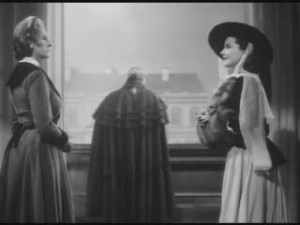 If you haven’t seen this film at all or not lately it’s rather hard to find except rare airings on TCM. It is available on VHS and laserdisc, but is as of now unavailable on DVD. Do make an effort as if you can overcome the propaganda slant it is fine entertainment.
If you haven’t seen this film at all or not lately it’s rather hard to find except rare airings on TCM. It is available on VHS and laserdisc, but is as of now unavailable on DVD. Do make an effort as if you can overcome the propaganda slant it is fine entertainment.
For those wishing to learn more about Vivien and Laurence, especially the tragic life of Vivien Leigh, please check out www.vivandlarry.com – a great trove of related information.
Great movie
Lady Hamilton !
“In the desert a fountain is springing,
In the wide waste there still is a tree,
And a bird in the solitude singing,
Which speaks to my spirit of thee”